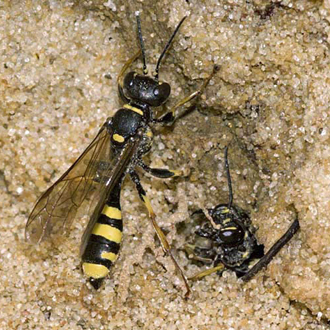


|
 |
 |
 |
 |
 |

|
 |
 |
|
The Mellininae subfamily is small. In fact with Mellinus crabroneus not seen in Britain since 1952 (the species was widespread but never common in the years leading up to the extinction), Mellinus arvensis (15mm) is the only member. The latter is certainly common and, as regards the female at any rate, a fairly large species whose tell-tale burrow diggings are found principally in sandy areas. Relative to the female the male is one of the smallest of all British wasps, as the The burrow, which is up to 40cm long, is excavated pretty quickly. There are a fair number of cells and the prey are medium-sized flies, which are caught in pretty quick succession - six a day at least. Piles of mammal dung are a popular site for females to lie in wait. The female wasps defend their nests vigorously against attempts by others to intrude. Sometimes brief but ferocious fights can occur. The active period of Mellinus arvensis seems to be growing longer with milder autumns, as observations in October and November 2005 confirmed. In July and August, a few were nesting in partial shade beneath the vegetation on the upper bank of the sandpit. In October, up to ten nests were present in a cone-shaped alcove in the bank facing south-west and receiving full sun at that time of year from midday to By November, three Mellinus arvensis were still nesting in the alcove and one remained active until November 19, including on days when the overnight temperature was at or below freezing and the day-time temperature did not reach 7C. One female caught prey on days when the maximum temperature was only around 11C, confirming the known fact that Mellinus arvensis (and Crabro cribrarius) can fly and forage in lower temperatures than almost any other solitary wasps in Britain. Oddly, they are not endothermic, yet the study wasps did minimal basking before flying away. Perhaps predictably given the temperatures, the wasps' efficiency evidently was lower in November than in October - one fly caught in a day, compared with four in the space of two hours on an afternoon towards the end of October when the On two other occasions sizeable flies were caught but the wasps proved unable to transport them to the nest. They seemed to abandon the attempt, eat part of the abdomen for between two and three minutes then leave the flies, one of which was taken away by a passing ant. (On another occasion an ant scavenged an earwig - both times the prey had to be taken up a vertical bank measuring 70cm.) There is little doubt that Mellinus arvensis is increasing in numbers nationally - there were getting on for 100 nesting females at the sandpit in 2007 and almost as many in 2008 and 2009. Given its adaptability and effectiveness at a time of year when there is minimal competition, the continuing success of the species should be assured. Images © Jeremy Early. All rights reserved. In 2013 I published My Side of the Fence - the Natural History of a Surrey Garden. Details may be found, and orders placed, via this hyperlink My Side of the Fence. In November 2015 Surrey Wildlife Trust published the atlas Soldierflies, their allies and Conopidae of Surrey, jointly written by David Baldock and me. Details are on this web page: Atlas. |